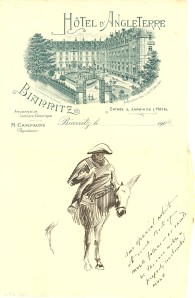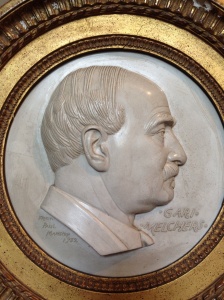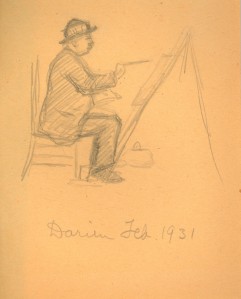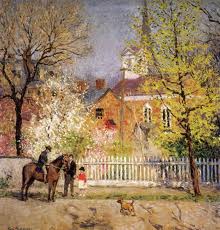A young woman working on the topic of Gari Melchers recently asked me if French impressionism was different from the impressionism practiced by American painters. What a good question! Even in French impressionism there are many variants, so let me try to give you a simple explanation.
In the 1870s impressionism emerged as an art movement of Paris-based artists, with Claude Monet as its leading exponent. Because it was considered an anti-academic art movement, even a scam by some, it initially met with harsh opposition, criticism which ironically seemed to help bring it into prominence and acceptance. Once it took off, the world never looked back, and in the last 50 years the best examples have fetched record setting prices.
So what was all the original fuss about? The impressionists were really after an authentic picture of the contemporary world around them, but their approach was diametrically opposed to the painting conventions practiced by the old state-sponsored art academy. And if you didn’t conform to their standards, you were thrown out on your ear, which is why the impressionists were forced to exhibit together in shows independent of the state-sponsored salon system. Throughout the 19th century, stylistic innovations typically spread quickly from Paris to other capitals of Europe. But it took a decade for impressionism to be accepted in the very place in which it was born.
How were the paintings of the impressionists different from the status quo? Firstly, the subjects they chose revolved around themselves and the leisure class, sometimes even the grittier side of life. Such themes were viewed by the academy as common compared to the elevated themes of history painting and the classical mythology they promoted, the themes of the impressionists certainly rankled them and their conventional tastes.
The impressionists often eschewed carefully balanced compositions in favor of cropped objects or things just out of view of the picture frame in order to heighten the impression of life captured in mid- action. These stylistic deviations also offended the conservatives.
And to further enhance the life-like immediacy of their subjects, which is at the heart of the most successful examples of impressionism, these art rebels aimed to convincingly reproduce observed light and its optical effects on reality, indoors and out.
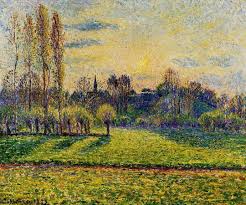
Camille Pissarro, View of Bazincourt, Sunset, 1892, private collection
In order to accomplish this, they employed loose, gestural brushstrokes that suggested or gave an “impression” of things seen rather than a literal replication of things. What’s more, they painted strokes of strong, pure color side by side rather than mixed together. The results were paintings that presented a view of the world through a glittering sunlit veil of color or a suffused atmospheric mantle of dim light, depending on the subject. Some of the group even attempted to apply in the execution of their pictures the findings of contemporary scientific studies on the chromatic effects of light. So impressionism was a new way of depicting experience; it even borrowed from the new technology of photography to achieve its expressive effects.
American artists, who by the 1870s felt it obligatory to have Paris training, were compelled to begin their study in the conservative art academies. Gradually they loosened their adherence to the old ways with the growing popularity of impressionism. Stylistically American art lagged behind European innovations by a good 10 to 20 years.

Childe Hassam, Isle of Shoals, Broad Cove, 1911, Honolulu Museum of Art
Impressionism was stylistically adopted into American practice according to three main routes. 1)French dealers brought sales and exhibitions of French impressionists works to the U.S. East coast cities from which it spread. 2)Many European-trained American artists who fell under the spell of impressionism returned stateside to teaching positions, passing on the lessons of their exposure to the art movement, and finally, 3)Many Americans studied directly under artists such as Monet and though they never returned home to work, were imitated by admiring American artists who witnessed their paintings in American shows, art journals and press of the day.
How was American Impressionism different?
The only real difference is
1) the subject- While in Europe, Americans loved to paint the same subjects as their European counterparts, i.e., the boulevards, the dance halls, open air parks, rolling meadows and seascapes, landmarks of Paris such as the cathedrals and train stations etc., but for the most part, with the First World War, many had repatriated and so began to paint the American scene in earnest rather than the European scene.
and
2) optics, and I overstate this to make a point,
Many Americans were reluctant to break down the 3-dimensional illusion of things in the way in which the French sometimes did. Often in French impressionist paintings, the outlines or hard edges of things, the contours of things, and the illusion of three dimensional space, dissolve under the harsh glare of rendered light to the point where the illusion of materiality is lost.
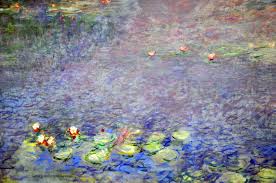
Claude Monet, Water Lilies, 1906, L’Orangerie, Paris
When you look at a Monet water lily pond, for example, sometimes you can’t be sure that what you are looking at has any basis in reality. The French tended to paint the canvas surface with vibrant sensuousness while Americans aimed for the same thing, but without losing a sense of the mass of things within a convincing illusion of space.

“Dance at Bougival” by Renoir, 1883, Boston Museum of Fine Arts
Auguste Renoir was the least impressionist of the French group in that many of his figurative paintings (people) have such implied mass.

Gari Melchers, Saint George’s Church, ca. 1920, Gari Melchers Home and Studio
Melchers adopted the subjects, palette and brushwork of the Impressionists and readapted it to the American scene when he returned to the States, but his figures remain very much of the material world in the way that do Renoir’s.







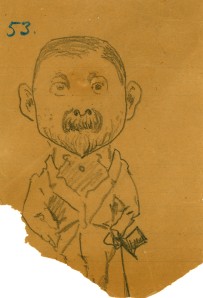
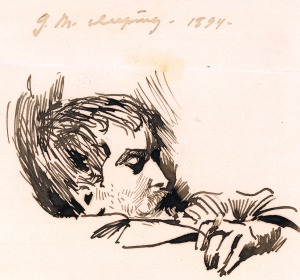
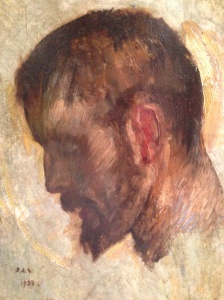




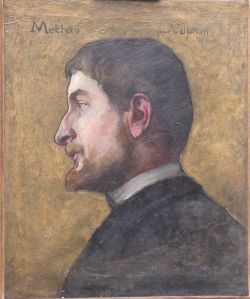
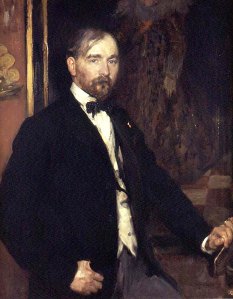 By the time of his marriage at age 43, Melchers was a critical and commercial success, and portraits of him convey a sense of his new found confidence and ease. I refer to James J. Shannon’s Portrait of Gari Melchers as an example. I tend to think of this as a wedding portrait, though that may not have been the official intent. Undoubtedly it was painted around the time of his vows, and his apparel is appropriately stylish and his wedding ring visible. Melchers’ likeness bears an air of dignity and taste, surrounded as he is by old world antiques like the Flemish portrait of an aristocratic girl and the Dutch candle sconce serving as decorative backdrop.
By the time of his marriage at age 43, Melchers was a critical and commercial success, and portraits of him convey a sense of his new found confidence and ease. I refer to James J. Shannon’s Portrait of Gari Melchers as an example. I tend to think of this as a wedding portrait, though that may not have been the official intent. Undoubtedly it was painted around the time of his vows, and his apparel is appropriately stylish and his wedding ring visible. Melchers’ likeness bears an air of dignity and taste, surrounded as he is by old world antiques like the Flemish portrait of an aristocratic girl and the Dutch candle sconce serving as decorative backdrop.